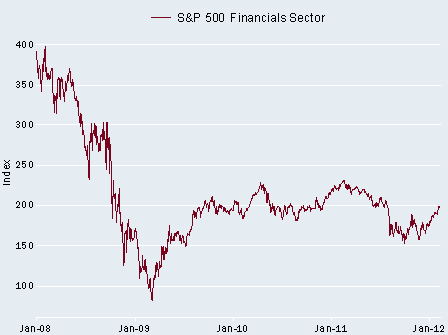During 2011, some of the smartest investment pros in the world bet heavily on Bank of America and lost big as the stock price collapsed.
Concerns over the looming collapse of the European banking system sent U.S bank stocks into a tailspin as panicked investors sold. From a price of $15 in January 2011 the share price of Bank of America (BAC) declined to a panic low of $4.92 in December.
After dropping to almost $3 per share during the height of the financial crisis, Bank of America had recovered to $20 per share by early 2010. The big question facing investors now is, where do we go from here? (See Buffet Says Bank of America Is A “Great Value.”)
Analyst Brad Sorensen of Charles Schwab took at look at financial stocks recently to assess whether financial stocks were a “Danger or Opportunity.” After citing the many challenges facing the banking industry, Sorensen concludes, with caveats, that Schwab expects the financial sector to “marketperform” in 2012.
The financial sector has been in the headlines, generally for less-than-stellar reasons, for the past several years, and it appears to us that investors may be more than a little gun-shy about allocating funds to the beaten-down group. But given that the sector constitutes roughly 14% of the S&P 500®, it’s too big to ignore. So, after a tumultuous ride over the past four years, what’s the current status of the group, and why are we currently rating it at marketperform in our Schwab Sector Views?
Perhaps you’re now wondering how we can advocate investing in such a maligned group and continue to hold a marketperform rating on the financials. First, it’s important to remember one of the first maxims of stock market investing—that stocks are forward-looking instruments. The disheartening list above is largely known by investors, has been well-publicized and much discussed, and, in our opinion, is likely at least largely reflected in current stock prices. In fact, there’s evidence investors are starting to look past these issues to future potential as financials began the year with close to an 8% price gain in January (based on the S&P 500 financial sector).
There are also some potential positive surprises to the burdensome issues described above. With regard to the regulatory environment, it’s difficult for us to imagine it getting much worse, while there is the possibility that at least some of the Dodd-Frank Act will be rolled back following the elections in November. Further, it appears that banks are starting to move out the risk spectrum a bit and are increasing lending activities, which can help boost profitability.
It’s also been our experience that it rarely pays to underestimate the ability of the financial sector to remake itself in a way that continues to grow the industry and profits. Once the rules are known, the game is typically played quite well by the brains behind the financials.
And while housing isn’t anywhere near a rousing recovery, it increasingly appears to us that there’s at least a decent bottom and that price declines on a wide-scale basis may be coming to an end. Interest rates remain extremely low and housing, based on historical levels, is quite affordable, which could help further support at least a modest improvement in the housing market.
There’s also hope that a settlement between major banks and the states can be reached in the near future regarding the way foreclosures were handled, potentially removing another uncertainty for the sector.
Finally, the European crisis is one of the longest-running that the financial world has seen. Institutions have had abundant time to prepare for possible defaults, leading us to believe that US exposure to European debt problems has been minimized.
What happens to the share price of Bank of America by year end is anyone’s guess, but if it has a recovery similar to that of 2008, Bank of America could make risk tolerant investors a tidy profit. At current prices, a move to $20 by year end would result in a 150% gain for stock investors.
Investors rampantly bullish on Bank of America could score much bigger gains by buying cheap call options on the stock. A perusal of Bank of America CBOE January 2013 call options show large open interests in strike prices of $10 and higher. Many of these options may be involved in arbitrage activity but it appears that many investors are betting on a big price recovery in BAC.
Just for fun, I looked at the January 2013 BAC call with a $12.50 strike price which is currently selling for $0.22. The call option gives the buyer the right to buy the stock at $12.50. An option on 100 shares at $12.50 would cost an investor $22.00 plus commission. If Bank of America’s stock price recovers to $20 per share by the end of January 2013, the call option costing $22 today would be worth at least $750.


Speak Your Mind
You must be logged in to post a comment.